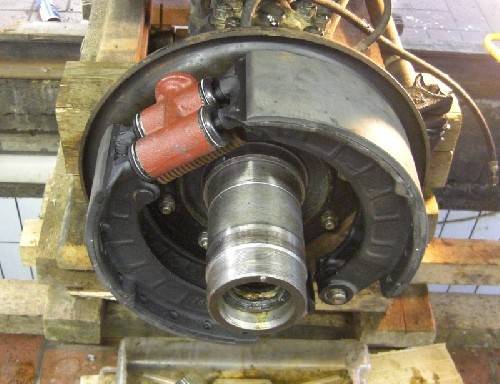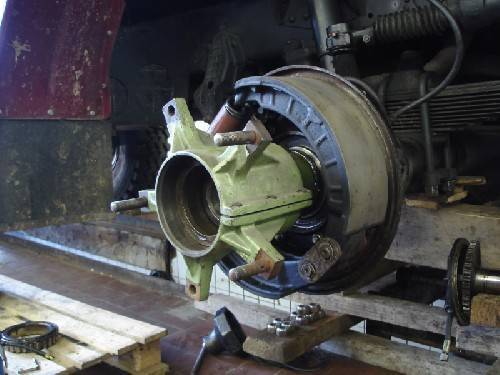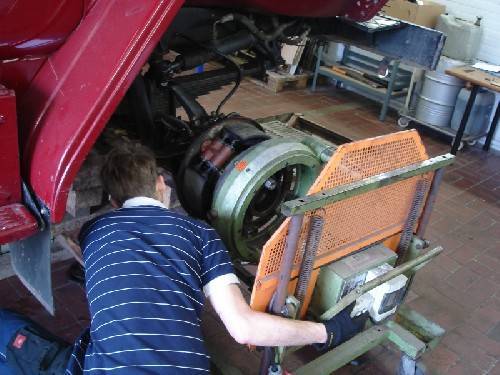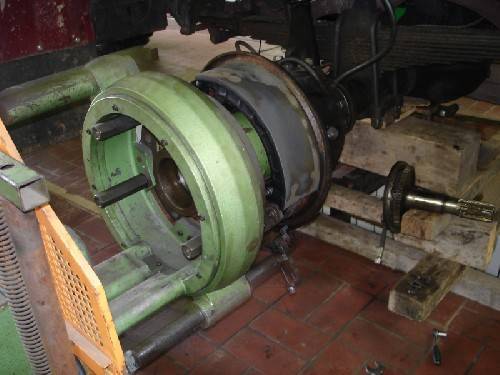Re: Ross Miller Tech Session
Posted by Guscha On 2011/9/24 19:31:28
Dave, thanks for the report and the flood of thoughts. I believe to know that both Ross and you won't find any news below but the following perhaps contains interesting stuff for others.
As we know disc brakes are better than drum brakes. But when talking about drum brakes then allow me to add a couple of thoughts. I would like to start with a theoretical reflection. To brake with drum brakes means to turn kinetic energy to heat by the help of friction. The tribological properties depends on:
a) the brake pressure
b) the size of friction surfaces
c) the surface condition
and other important parameters like drum temperature but I want to focus on the above mentioned proberties. Instead of longwinded explanations the following question shall confront you with the importance of
a) the brake pressure
During your military service have you ever sat on a cargo area of a truck, equipped with drum brakes and braked by compressed air? If yes, then you know that it makes no difference if the truck has drums or discs (normal load, no mountainside). The compressed air made the difference and changed even the strongest Private First Class into a flying Airman First Class. If neccesary then even a heavy vehicle stops faster than good for its load. When talking about the quality of drum brakes please make sure to talk about the complete system. To lose brake pressure starts at the first fulcrum of the brake pedal, continues in aged brake fluid, a sluggish master brake cylinder, kinked lines, bulbous hoses, soiled brake cylinders and dirt crunching brake shoes.
Ross respectively Dave talked about turned drums to increase
b) the size of friction surface
But how about the antagonist? Please find attached pics of a circumferential scraper plane. Whenever in use it tellingly shows that new brake shoes are not perfectly round.
Which leads to
c) the surface condition
The usual way is that people talking about a "settling in period". One reportedly has to accept that drum and new lining have to reseat but after 100 miles everything would be great.
I doubt that.
After 100 miles the spotty fitting lining is burned, has changed to glaze with the hardness of glass, perfect for striae formation on the inner surface of the drums.
Attach file:
 (95.19 KB)
(95.19 KB)

 (63.10 KB)
(63.10 KB)

 (78.76 KB)
(78.76 KB)

 (61.09 KB)
(61.09 KB)

As we know disc brakes are better than drum brakes. But when talking about drum brakes then allow me to add a couple of thoughts. I would like to start with a theoretical reflection. To brake with drum brakes means to turn kinetic energy to heat by the help of friction. The tribological properties depends on:
a) the brake pressure
b) the size of friction surfaces
c) the surface condition
and other important parameters like drum temperature but I want to focus on the above mentioned proberties. Instead of longwinded explanations the following question shall confront you with the importance of
a) the brake pressure
During your military service have you ever sat on a cargo area of a truck, equipped with drum brakes and braked by compressed air? If yes, then you know that it makes no difference if the truck has drums or discs (normal load, no mountainside). The compressed air made the difference and changed even the strongest Private First Class into a flying Airman First Class. If neccesary then even a heavy vehicle stops faster than good for its load. When talking about the quality of drum brakes please make sure to talk about the complete system. To lose brake pressure starts at the first fulcrum of the brake pedal, continues in aged brake fluid, a sluggish master brake cylinder, kinked lines, bulbous hoses, soiled brake cylinders and dirt crunching brake shoes.
Ross respectively Dave talked about turned drums to increase
b) the size of friction surface
But how about the antagonist? Please find attached pics of a circumferential scraper plane. Whenever in use it tellingly shows that new brake shoes are not perfectly round.
Which leads to
c) the surface condition
The usual way is that people talking about a "settling in period". One reportedly has to accept that drum and new lining have to reseat but after 100 miles everything would be great.
I doubt that.
After 100 miles the spotty fitting lining is burned, has changed to glaze with the hardness of glass, perfect for striae formation on the inner surface of the drums.
Attach file:
 (95.19 KB)
(95.19 KB)
 (63.10 KB)
(63.10 KB)
 (78.76 KB)
(78.76 KB)
 (61.09 KB)
(61.09 KB)
This Post was from: https://packardinfo.com/xoops/html/modules/newbb/viewtopic.php?post_id=86726